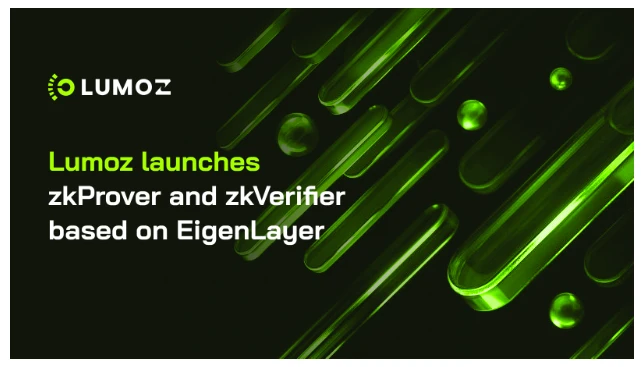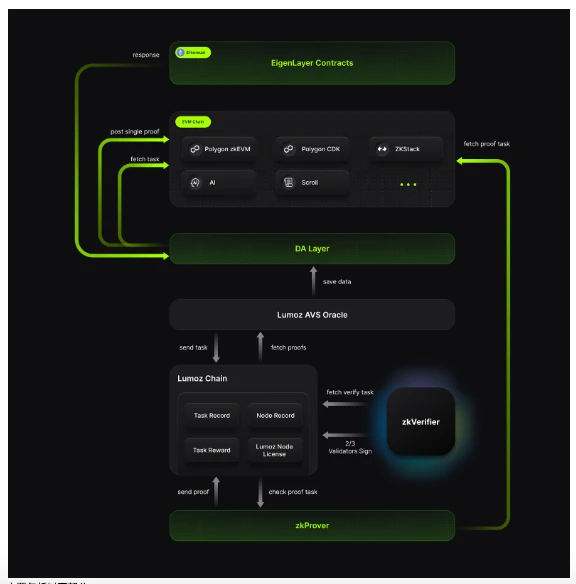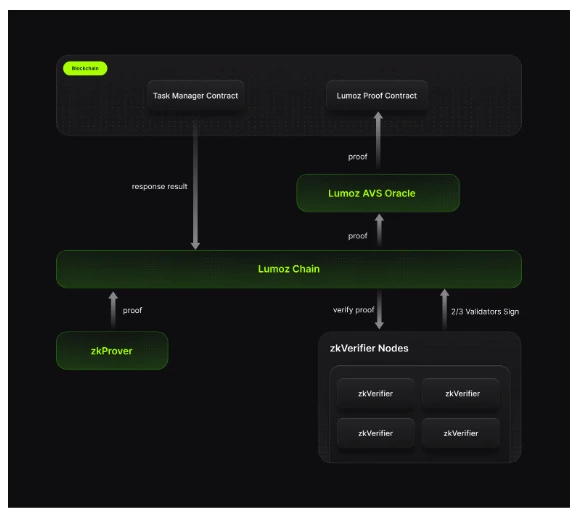Lumoz lanza zkProver y zkVerifier basados en EigenLayer
Despite the recent airdrop controversy, there is no doubt that EigenLayer has become the most watched star project in 2024 with its re-staking mechanism. Its excess returns not only helped TVL to soar, but also allowed users to decisively withdraw from the vortex of the Golden Dog Meme and return funds and confidence to the Ethereum ecosystem.
As of press time , EigenLayers ETH TVL has exceeded 5 million ETH, the number of staked Eigen tokens has exceeded 54 million, and the number of active AVS ( Actively Validated Services ) and Operators are 11 and 251 respectively. Currently, the EigenLayer ecosystem has also ushered in an explosion, and more than 20 track leaders such as Lumoz, Espresso, Near, and Dodo have also participated in it.
Suddenly, a revolution centered around ETH and using Eigenlayer to reshape blockchain security and profitability began.
This article will take Lumoz as an example to explore in depth a series of technical explorations conducted by the project on EigenLayer, thereby further promoting the technological progress of Ethereum and the entire blockchain industry.
1. Lumoz announces the launch of AVS computing layer based on EigenLayer
As the leader of modular computing power layer and ZKRass, Lumoz not only performs well in the capital market, but also continues to innovate in the field of technology. In April 2024, Lumoz first announced the completion of Pre-A financing (currently valued at US$300 million), and then announced support for the Layer 2 architecture of Op Stack + ZK Fraud Proof, opening a new model of L2 architecture.
This week, Lumoz announced the official launch of the AVS computing layer based on EigenLayer, which consists of zkProver and zkVerifier, and can significantly improve the computing power and security of the network.
Lumozs zkProver focuses on generating zero-knowledge proofs (ZKPs) to verify data authenticity without revealing specific data. With powerful computing resources, zkProver is able to quickly generate efficient zero-knowledge proofs, significantly improving the privacy and security of blockchain networks. zkVerifier is responsible for verifying these zero-knowledge proofs to ensure their correctness and reliability. Combined with the EigenLayer re-staking mechanism, zkVerifier not only leverages the security of Ethereum, but also provides additional economic incentives for verifiers. This dual verification mechanism greatly enhances the overall security of the network and reduces trust risks.
Note: EigenLayers re-staking mechanism enhances the security of the Ethereum ecosystem and solves trust issues and capital cost burdens by providing AVS.
By integrating powerful computing resources with EigenLayers re-staking mechanism, Lumoz has created an efficient and secure computing service ecosystem. This innovation not only improves the computing power and security of the blockchain network, but also provides more application scenarios and value for developers and users. Through zkProver and zkVerifier, Lumoz has brought unprecedented innovation and value to the blockchain field and promoted technological progress in the entire industry.
2. Lumoz Computation Layer
The Lumoz computing layer architecture is a highly integrated and coordinated system with the following main components and functions:
It mainly includes the following parts:
-
Ethereum: Adopting the EigenLayer standard to build an active verification service (AVS). Using EigenLayers staking token mechanism to enhance the security of AVS
-
EVM Chain: A diverse blockchain environment that supports the Ethereum Virtual Machine (EVM), including but not limited to Polygon zkEVM, Polygon CDK, ZKStack, and Scroll, ensuring broad compatibility and scalability
-
Lumoz AVS Oracle: Responsible for obtaining and saving data from EVM-compatible chains, ensuring high availability and integrity of data, and providing a solid data foundation for the computing layer
-
Lumoz Chain: As the core management layer of the entire computing layer, it is responsible for task scheduling, reward distribution, and the management of zkProver and zkVerifier, including but not limited to the node joining and exiting process
-
zkProver: A node that performs specific computational tasks
-
zkVerifier: Verification node that verifies execution results
Through the close collaboration of these modules, the Lumoz computing layer not only provides a secure and efficient computing environment, but also lays a solid foundation for future expansion and upgrades through modular design.
3. What problems can be solved?
3.1 Large-scale computing power requirements
The cloud infrastructure provided by Lumoz provides strong support for the computation of zero-knowledge proofs. This support is very important for ZK-Rollups, which is a blockchain scaling solution that reduces the load on the main chain and increases transaction throughput by executing transactions off-chain and using ZKP to prove the validity of transactions, and then submitting these proofs on-chain.
Lumoz Cloud Infrastructure Capabilities:
-
Compatibility: Lumoz鈥檚 cloud infrastructure is compatible with multiple ZK-Rollup solutions such as Polygon CDK, zkSync, StarkNet, and Scroll. This means that it can provide services to these different platforms without requiring each platform to build its own infrastructure separately.
-
ZK-PoW Algorithm: Lumoz combines the computing resources of miners and cloud infrastructure, and through the ZK-PoW (Zero-Knowledge Proof of Work) algorithm, miners can contribute their computing power to support ZKP calculations.
-
Performance and efficiency: By supporting parallel computing of ZKP, computing efficiency can be significantly improved because multiple computing tasks can be performed simultaneously. In addition, sequential submission ensures that transactions are processed in order.
-
Recursive Aggregation Algorithm: Optimizing the recursive aggregation algorithm can reduce the number of ZKPs required, thereby reducing computational complexity and cost.
-
Network communication improvements: Improved network communications can reduce data transfer time and improve overall system responsiveness.
-
Cost-effectiveness: Through the above optimizations, Lumoz is able to reduce the cost of ZKP computations, making solutions using ZK-Rollups more cost-effective.
Lumozs cloud infrastructure provides a powerful, flexible and cost-effective solution for ZKP computations, helping to advance the development and application of blockchain technology.
3.2 Reduce zk proof Gas
The design strategy of zkVerifier aims to improve efficiency, enhance scalability, and effectively reduce transaction costs, which is specifically reflected in the following aspects:
-
Integration of multi-source proofs: zkVerifier is able to integrate proofs from different sources, supporting a wide range of zero-knowledge proof application scenarios. This flexibility is a key advantage in the blockchain ecosystem because it provides the possibility for different projects and applications to utilize zkVerifier services.
-
Gas cost savings: Through a carefully designed proof processing and verification mechanism, zkVerifier significantly reduces the gas cost of submitting proofs, bringing users a more cost-effective blockchain service experience.
-
Adaptability of proof characteristics: zkVerifier demonstrates adaptability to the proof characteristics generated by different proof systems, including proof size, verification time, and verification logic. This adaptability is core to ensure the efficient operation of the system.
-
Customized release strategy: Based on the characteristics of different proofs, zkVerifier designs customized release strategies, optimizes the use of on-chain resources, and ensures efficient delivery of proofs, which helps reduce network congestion and improves transaction speed.
-
Deployment of dedicated validators: zkVerifier deploys dedicated validators, which is a key mechanism to ensure the validity of proofs. These validators ensure that only verified proofs can be published to Ethereum, maintaining the security and reliability of the system.
-
Optimization of data availability layer: zkVerifier鈥檚 data availability layer ensures the durability and accessibility of proofs while providing a cost-effective storage strategy, which is critical to reducing the operating costs of the system.
-
Deep integration with Ethereum: zkVerifier publishes the verification results to Ethereum, and Ethereum generates verification proofs. This step is key to ensuring cross-chain interoperability and trust, and helps zkVerifier work seamlessly with major blockchain networks such as Ethereum.
-
Authority of verification proof: The verification proof generated by Ethereum provides the final authoritative confirmation of the validity of the data provided by zkVerifier, which is critical to establishing the Ethereum network鈥檚 trust in zkVerifier data.
These innovative designs of zkVerifier not only solve the challenges faced by existing blockchain technology, but also make significant progress in improving efficiency, reducing costs and enhancing interoperability. This design helps promote the wider application of blockchain technology and provide users with a safer and more efficient service environment.
4. Specific workflow
4.1 zkProver
zkProver is the core component for generating zero-knowledge proofs. ZKP allows a prover to prove the correctness of an assertion to a verifier without revealing any additional information. zkProver includes multiple prover types, such as zkRollup Prover, zkFraud Prover, and zkML Prover, each of which is optimized for specific computing tasks to ensure the best performance and system efficiency in a specific field.
work process:
-
Task acquisition: Lumoz AVS Oracle and Dispatch modules acquire tasks from the blockchain and synchronize them to Lumoz Chain. These tasks are assertions or calculations that need to be proven.
-
Task distribution: Tasks are distributed to different Provers through the Dispatch module. As the task scheduling center, Dispatch determines which type of Prover is most suitable for handling the task based on the nature and requirements of the task. The Dispatch module dynamically allocates computing resources through intelligent algorithms, optimizes resource allocation in real time based on task load and the performance of each Prover, and ensures stable operation of the system during high-demand periods.
-
Proof Generation:
-
zkRollup Prover: Focuses on processing proofs related to transaction batch compression, suitable for improving blockchain processing speed and scalability.
-
zkFraud Prover: Used to generate fraud proofs that can help detect and prevent improper behavior.
-
zkML Prover: Specializes in handling the complex proofs associated with machine learning model verification, verifying the model鈥檚 output without revealing the model itself or its input data
-
Other Prover: Other Prover used for specific proof
4. Proof submission: The generated proof is sent to Lumoz Chain for verification and archiving
4.2 zkVerifier
zkVerifier is another key component in the architecture, responsible for verifying the ZKP generated by zkProver. It ensures the correctness and validity of the proof submitted to the chain, ensuring the trust and security of the system. Through the optimized verification process, zkVerifier processes proofs efficiently, reducing operating costs and gas consumption.
work process:
-
Proof submission: The proof generated by zkProver is submitted to Lumoz Chain to start the verification task
-
Proof Verification: Lumoz Chain sends verification tasks to multiple zkVerifier nodes, which perform distributed verification independently.
-
Collective decision-making: At least two-thirds of the verification nodes confirm that the proof is valid, ensuring the authority and consistency of the verification results
-
Verification result processing: The valid proof and its results are sent back by Lumoz AVS Oracle to the Lumoz Proof Contract on the blockchain for storage, and the task results are recorded and responded to Lumoz Chain through the Task Manager Contract.
5. Conclusión
Lumoz announced the launch of zkProver and zkVerifier based on EigenLayer, which not only significantly enhances the efficiency of computing and verification, but also effectively ensures the security and benefits of the entire service process through EigenLayers re-staking mechanism. Through professional node design, Lumoz is able to provide solutions for different computing tasks to achieve optimal performance and efficiency. At the same time, through the re-staking mechanism, Lumoz provides substantial benefits to pledgers, further enhancing the economic security of the system.
In the future, we also hope to see more projects like EigenLayer and Lumoz emerge, face up to the current blockchain dilemma, truly solve user pain points from a practical perspective, and actively explore and try more efficient and secure solutions, thereby promoting the progress and prosperity of the entire industry.
This article is sourced from the internet: Lumoz launches zkProver and zkVerifier based on EigenLayer
Relacionado: Las cripto ballenas compran $24,8 millones en inyección (INJ): impacto en el precio
En resumen, Injective notó una corrección de 16% en la última semana y ahora se mantiene por encima de $30. Las cripto ballenas agregaron INJ por valor de $24,80 millones en un día a medida que el precio caía. La divergencia de DAA durante los últimos dos días podría desencadenar una recuperación del precio inyectivo. El precio del inyectable (INJ) está intentando recuperarse después de caer por encima del nivel de soporte $35, marcando un mínimo mensual. Las cripto ballenas probablemente serán los catalizadores de la recuperación, dada su reciente acumulación masiva de INJ. El precio de Crypto Whales Support Recovery Injective se cotiza actualmente a $34 después de corregir en más de 16% la semana pasada. Durante el mismo período, la actividad de la red creció, como se puede notar en las direcciones activas diarias (DAA). En los casos en que el precio cae y DAA sube, el mercado muestra una compra...











